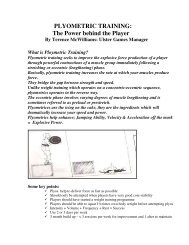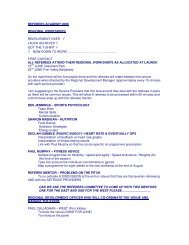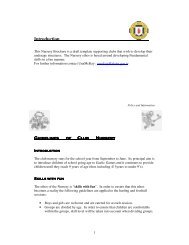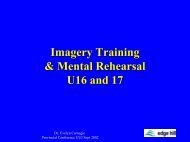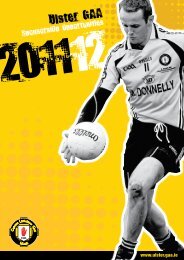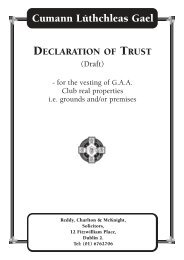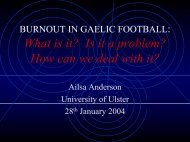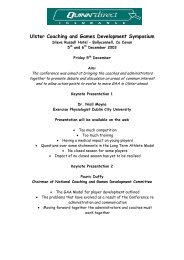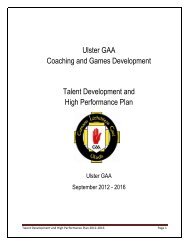Coaching Defensive Play in Gaelic Football Philip Kerr ... - Ulster GAA
Coaching Defensive Play in Gaelic Football Philip Kerr ... - Ulster GAA
Coaching Defensive Play in Gaelic Football Philip Kerr ... - Ulster GAA
Create successful ePaper yourself
Turn your PDF publications into a flip-book with our unique Google optimized e-Paper software.
<strong>Coach<strong>in</strong>g</strong> <strong>Defensive</strong> <strong>Play</strong> <strong>in</strong> <strong>Gaelic</strong> <strong>Football</strong><br />
<strong>Philip</strong> <strong>Kerr</strong> and Paddy Flynn<br />
Mid-<strong>Ulster</strong> Sports Arena<br />
Wednesday 25 th January<br />
Before outl<strong>in</strong><strong>in</strong>g the format, we must reiterate what was mentioned to coaches<br />
who attended. We feel that too many still see a session on defensive play as an<br />
opportunity to simply pick up a dozen tackl<strong>in</strong>g drills. If this were the case why<br />
would the <strong>Ulster</strong> Council run a separate CPD night called ‘<strong>Coach<strong>in</strong>g</strong> the<br />
Tackle’? Of course, tackl<strong>in</strong>g is at the core of good defensive work, but so are<br />
pr<strong>in</strong>ciples like delay, control, balance, concentration and depth.<br />
With this <strong>in</strong> m<strong>in</strong>d we made a conscious decision to be different and l<strong>in</strong>k exercises<br />
[drills and games] to observation of real play. Whether it is through watch<strong>in</strong>g<br />
live football or a video record<strong>in</strong>g, opportunities exist where coaches may glean<br />
<strong>in</strong>formation about <strong>in</strong>dividual players or groups of players and their defensive<br />
frailties.<br />
As you read the transcript of the session, th<strong>in</strong>k how you might observe some<br />
matches this com<strong>in</strong>g season and use aspects of them design drills and games <strong>in</strong><br />
order to improve one or more players <strong>in</strong> your squad…..and remember…<br />
DRILLS ALONE will not solve your problems!<br />
The Session<br />
1. Sixteen players from O’Donovan Rossa U16 squad acted out the various drills<br />
and game situations dur<strong>in</strong>g the session.<br />
We gave out cards to a small number of coaches. Each card identified a team<br />
and a particular player with<strong>in</strong> that team [see the sample at the foot of this<br />
transcript].<br />
We asked each coach to watch his nom<strong>in</strong>ated player dur<strong>in</strong>g the short game [5<br />
m<strong>in</strong>utes] and look for any defensive shortcom<strong>in</strong>gs he might have. Each card<br />
had a short check to prompt the coach.<br />
We asked all other coaches to choose a player or two to focus on dur<strong>in</strong>g the<br />
game and th<strong>in</strong>k about the advice they might give.<br />
2. At the end of the game we <strong>in</strong>vited each ‘card hold<strong>in</strong>g coach’ to take his<br />
player aside [one-to-one situation] and po<strong>in</strong>t out to that player ONE aspect of<br />
his defensive game that he should work on.<br />
Other coaches were rem<strong>in</strong>ded that they had just been watch<strong>in</strong>g with a<br />
particular focus. Would it be worth do<strong>in</strong>g this back at the club?
3. The game resumed [for a further 3 m<strong>in</strong>utes] to allow players to follow some of<br />
the advice. One player, for example, was told that he had got drawn towards<br />
the ball on two occasions while his opponent moved beh<strong>in</strong>d him and received<br />
a lobbed pass over the top. It didn’t happen <strong>in</strong> the second part of the game.<br />
5. As players got dr<strong>in</strong>ks and moved off to help set the first drill, we talked to<br />
coaches about how they should make more use of observ<strong>in</strong>g aspects of games<br />
to spot and fix problems. We said that that we had done just that with the<br />
Tyrone v Dubl<strong>in</strong> drawn game and had chosen a selection of defensive<br />
situations from that particular match to help us design some practical exercises<br />
for tonight’s session.<br />
6. The first two match situations were run as drills. We split the coaches to watch<br />
two situations<br />
a. The ‘Sherlock v McMenam<strong>in</strong>’ play – it happened twice <strong>in</strong> the first<br />
half [8 th and 29 th m<strong>in</strong>ute] and Sherlock scored on both occasions.<br />
Instead of play<strong>in</strong>g the ball from a 30m kick pass, we shortened the<br />
delivery <strong>in</strong>to the one-v-one drill to reduce the chances of the ball go<strong>in</strong>g<br />
astray. Ma<strong>in</strong> coach<strong>in</strong>g po<strong>in</strong>ts were about footwork, focus on midriff,<br />
know<strong>in</strong>g if he favours a particular foot.<br />
Repeat the drill on<br />
this side too<br />
Red player is the feeder [shortened to 5m from the action]. Yellow is<br />
Sherlock and the white player is McMenam<strong>in</strong>.<br />
Yellow starts the drill by mov<strong>in</strong>g quickly to the cone set at an angle to the<br />
rest. White responds to close yellow down. Yellow turns to fe<strong>in</strong>t and side<br />
step, try<strong>in</strong>g to throw white off balance and make room for the shot. The<br />
action all takes place on or about the 20m l<strong>in</strong>e. <strong>Play</strong>ers rotate to suit. The<br />
ma<strong>in</strong> coach<strong>in</strong>g po<strong>in</strong>t is that the defender [white] should stay balanced and<br />
focused on his opponent’s midriff rather than follow the fe<strong>in</strong>t.
. At the same time, Paddy ran the ‘Over the Top’ game - across the<br />
pitch and with 3v3, 4v3, 3v4 and 4v4 comb<strong>in</strong>ations to replicate the<br />
first-half long pass <strong>in</strong> from Paul Casey, which flew over the Dubl<strong>in</strong><br />
forwards and was swept up by Chris Lawn. <strong>Play</strong>ers [both forwards<br />
and defenders] found themselves chas<strong>in</strong>g towards Lawn – how do the<br />
backs work it out? Are forwards drawn to the ball? Where will the<br />
extra man go?<br />
OVER THE TOP [GAME]<br />
A 4v4 exercise where 4 attackers [red] l<strong>in</strong>e up along the halfway l<strong>in</strong>e and 3 defenders<br />
[white] face them 5m away. [Defenders may<br />
even start <strong>in</strong> press-up position]. The f<strong>in</strong>al<br />
defender stands some 20m beh<strong>in</strong>d his teammates.<br />
The width of the play<strong>in</strong>g area is set at<br />
30m-40m [use multimarkers and one sidel<strong>in</strong>e].<br />
One attacker has the ball and lobs it over the l<strong>in</strong>e<br />
of defenders towards the lone player. Defenders<br />
are forced to turn and f<strong>in</strong>d support positions.<br />
The attackers close down the defenders who<br />
must work it out over the halfway l<strong>in</strong>e to earn a<br />
po<strong>in</strong>t. Should the attackers w<strong>in</strong> the ball back,<br />
they must work it over the 20m l<strong>in</strong>e to score.<br />
Swap roles, repeat, give players the chance to<br />
work out moves etc.<br />
7. From here we moved to set up a game play called ‘Lose It, W<strong>in</strong> it’ to make<br />
the l<strong>in</strong>k between Paddy’s game and the situation that existed for the Dubl<strong>in</strong><br />
goal [14 passes etc. 36 m<strong>in</strong>utes]. Brian McGuigan’s shot had landed <strong>in</strong> the<br />
goalkeeper’s hands and Dubl<strong>in</strong> moved the ball upfield to score a goal. We set<br />
up the exercise and ran it 3 times for reds and 3 for whites – we asked coaches<br />
to look for any players who found themselves drawn to the ball when they had<br />
little or no chance of reach<strong>in</strong>g it – leav<strong>in</strong>g an opponent free to cont<strong>in</strong>ue the<br />
move.
LOSE IT/WIN IT [GAME]<br />
Simulates those match situations when forwards have made good runs to get a pass<br />
from midfield but the pass has been misdirected<br />
and ended up with the opposition goalkeeper .<br />
To properly copy this, force forwards to stand at<br />
multi-markers at least five or six metres away<br />
from any backs. . The ball starts with the<br />
goalkeeper. He throws it <strong>in</strong> the air and catches it<br />
to signal ‘game on’. The forwards immediately<br />
try to stop the backs gett<strong>in</strong>g the ball out easily<br />
and carry<strong>in</strong>g it over the halfway l<strong>in</strong>e. Do this<br />
over and over to work on suppress<strong>in</strong>g a<br />
forward’s <strong>in</strong>st<strong>in</strong>ct to simply watch where the<br />
ball goes and to improve his ability to close an<br />
opponent down.<br />
8. The next game Pay the Price – we <strong>in</strong>troduced this through reference to a<br />
number of situations where both Tyrone and Dubl<strong>in</strong> ran at opposition defences<br />
– one <strong>in</strong> particular – 47 m<strong>in</strong>utes gone – Dubl<strong>in</strong> 1-11 Tyrone 0-10 - Dubl<strong>in</strong><br />
kickout, ball broken down to Sean Cavanagh – he runs at Dubl<strong>in</strong> and is<br />
forced wide - all other players are picked up - he is 25m out and pos<strong>in</strong>g no<br />
real danger – Paul Casey shoves him <strong>in</strong> the back – Stephen O’Neill scores<br />
Pay the Price is designed to make players do their jobs and refra<strong>in</strong> from<br />
foul<strong>in</strong>g <strong>in</strong> the scor<strong>in</strong>g zone.<br />
PAY THE PRICE [GAME]<br />
What about a game to allow defenders to work on tackl<strong>in</strong>g without foul<strong>in</strong>g? What if<br />
the same game gave forwards the <strong>in</strong>centive to<br />
get closer to goal and even draw 'frees' from the<br />
opposition?<br />
Set up a large circle [diameter 40m]. <strong>Play</strong> backs<br />
v forwards to the halfway or far 45m l<strong>in</strong>e. The<br />
goalkeeper plays for the defenders. Start each<br />
play with a kick-out. Let the forwards take<br />
possession and attack. Only po<strong>in</strong>ts count.<br />
Should the attackers shoot and score from outside the circle, they are awarded 1 po<strong>in</strong>t.<br />
A score from <strong>in</strong>side the zone earns 2 po<strong>in</strong>ts. A 'free' scored from <strong>in</strong>side the zone earns<br />
3 po<strong>in</strong>ts.<br />
Defenders must work to keep the scores to a m<strong>in</strong>imum, so they must make sure they<br />
do not commit fouls <strong>in</strong>side the zone and that they mark tightly enough to keep down<br />
the number of 2 po<strong>in</strong>t scores. Defenders can earn scores for themselves, by w<strong>in</strong>n<strong>in</strong>g<br />
the ball and work<strong>in</strong>g it up the pitch to cross the halfway l<strong>in</strong>e or far 45m l<strong>in</strong>e while still<br />
<strong>in</strong> possession. The coach can determ<strong>in</strong>e how many po<strong>in</strong>ts should be given. Try<br />
it...show defenders that if they are too rash and if the defence lacks balance they will<br />
pay the price!
10. Hav<strong>in</strong>g looked at defensive play from forwards and from backs, we then took<br />
a situation from the middle part of the field – from kickouts – the best example<br />
from the match came on 60 m<strong>in</strong>utes – Dubl<strong>in</strong> kickout on 1-12 apiece – Brian<br />
Dooher is under the flight of the ball but doesn’t contest it – <strong>in</strong>stead, he breaks<br />
free from the midfield bunch to take a pass – no Dubl<strong>in</strong> player follows as all <strong>in</strong><br />
the middle are still drawn to the ball– Dooher kicks a po<strong>in</strong>t.<br />
We used a 4v4 exercise called ‘Breakout’ to work on defend<strong>in</strong>g aga<strong>in</strong>st this.<br />
BREAKOUT<br />
.<br />
Red<br />
Yellow<br />
Set a circle along halfway l<strong>in</strong>e. 8 players <strong>in</strong>side. Lob the ball <strong>in</strong> [<strong>in</strong>stead of kickout].<br />
Team that w<strong>in</strong>s the ball must work it with max. two-touch football over the 20m l<strong>in</strong>e.<br />
Emphasis is on team that loses ball. <strong>Play</strong>ers must develop defensive <strong>in</strong>st<strong>in</strong>cts where<br />
they are NOT drawn to the ball player, but can switch quickly to mark another<br />
opponent and cut the ball player’s options. Only one player needs to tackle the ball<br />
player head on. Once a play is f<strong>in</strong>ished, have 8 more ready to step <strong>in</strong>. Keep rotat<strong>in</strong>g.<br />
11. We f<strong>in</strong>ished with the ‘Two <strong>Play</strong>ers’ game. This allows most to take part <strong>in</strong> a<br />
normal game, while two players [<strong>in</strong> direct opposition – e.g. one midfielder<br />
from each side] are taken aside before the game and quietly given the<br />
follow<strong>in</strong>g rules by which only they must play:<br />
Should one or the other score dur<strong>in</strong>g the game, the actual score will be trebled<br />
[e.g. 1 po<strong>in</strong>t = 3 po<strong>in</strong>ts…1 goal = 3 goals]. Should either assist a score [i.e.<br />
f<strong>in</strong>al pass], the score will be doubled.<br />
This is best used to force ‘lazy’ player who only likes go<strong>in</strong>g forward to work<br />
harder and learn the value of cover<strong>in</strong>g back.<br />
Remember, should any coach have two ‘lazy’ [but talented] players <strong>in</strong> the<br />
team and not address the problem dur<strong>in</strong>g sessions, the chances of success<br />
on the pitch are m<strong>in</strong>imal!<br />
The session f<strong>in</strong>ished at 9.30p.m.<br />
See below for sample of ‘<strong>Coach<strong>in</strong>g</strong> Card’ given to a selection of coaches at the<br />
beg<strong>in</strong>n<strong>in</strong>g of the session.
<strong>Coach<strong>in</strong>g</strong> Card<br />
Dur<strong>in</strong>g this short game you should watch……..<br />
PLAYER NUMBER – ?<br />
From the RED / WHITE team;<br />
Make a note of any defensive frailties he may<br />
have.<br />
Here is a short checklist to help:<br />
Does he tend to rush <strong>in</strong>to the tackle?<br />
Is he easy to evade? [poor footwork]<br />
Does he forget to cover back for his teammates?<br />
Does he tend to follow the ball and lose track of<br />
his direct opponent?<br />
Is he caught out of position very often?<br />
At the end of the short game, you should talk<br />
one-to-one with your nom<strong>in</strong>ated player and give<br />
him advice on ONE ASPECT of his defensive<br />
play which needs improved.




